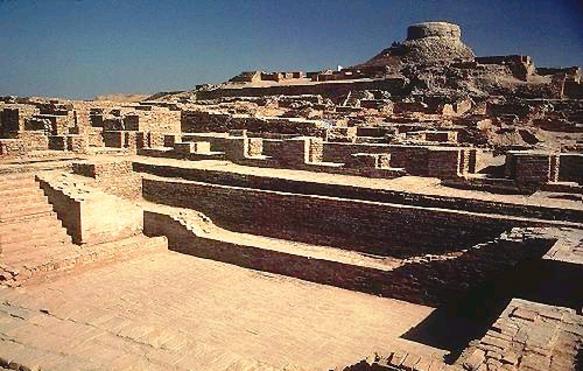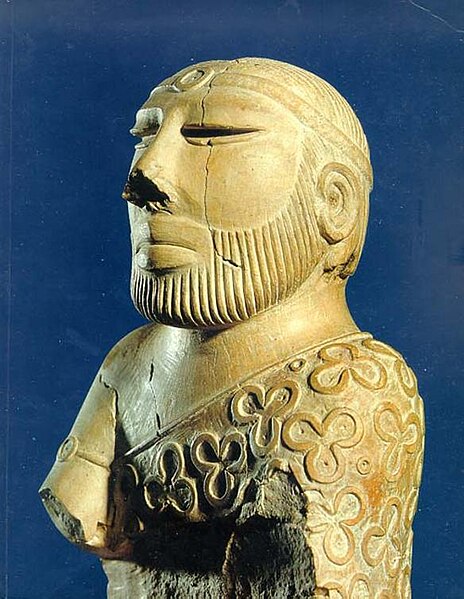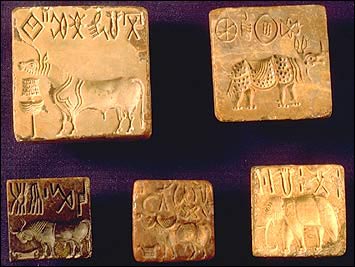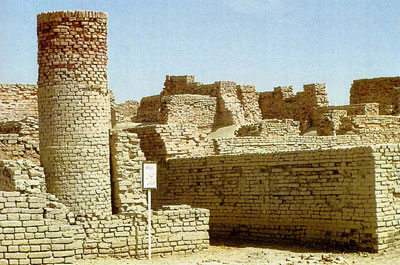BACK NEXT
Excavated ruins of Mohenjo-daro, Pakistan.

So-called "Priest King" statue, Mohenjo-daro, late Mature Harappan period, National Museum, Karachi, Pakistan

Mohenjo-daro, 25 km southwest of Larkana,Pakistan, was centre of the Indus Valley Civilization 2600 BC-1900 BC

A clay toy from Mohenjo-daro

Remains from the final phase of the Harappa occupation: A large well and bathing platforms


A figurine from Mehrgarh, c. 3000 BCE. (Musée Guimet, Paris)

Harappa in Pakistan

Harappa Seals

Harappa Jewelry

I especially like this photograph. It shows a quite well overview of the ancient "city".

Aerial view of the great bath at Mohenjo-Daro

Mohenjo-Daro

Well at Mohenjo-Daro

The Great Bath at Mohenjo-Daro

Seal from Mohenjo-Daro
Mohenjo-daro (Urdu: موئن جودڑو, Sindhi: موئن جو دڙو, English: Mound of the dead) was a city of the Indus Valley Civilization built around 2600 BC and is located in the Sindh Province of Pakistan. This ancient five thousand year old city is the largest of Indus Valley and is widely recognized as one of the most important early cities of South Asia and the Indus Valley Civilization. Mohenjo Daro was one of the world’s first cities and contemporaneous with ancient Egyptian and Mesopotamian civilizations. It is sometimes referred to as "An Ancient Indus Valley Metropolis"

The Great Bath at Mohenjo-Daro

Among the remains of the Mohenjo-Daro archaeological site in present-day Pakistan were terra-cotta, alabaster, and marble figures. This fragment shows a bearded male in ornamental dress dating from 3000 bc.

About five thousand years ago when Egyptians and Sumerians were building magnificent tombs and temples, but living in mud huts, a highly developed urban civilisation flourished in the Indus Valley, extensive remains of which have been found at various sites in Pakistan. Of these ancient sites two of the most well known are Harappa in Punjab and Mohenjo-Daro in Sind.
Copper and Bronze objects were first cast and then hammered to required shape. Stone axes and flake-knives have also been found in several houses of Mohenjo-Daro proving that the arts of the Stone Age had not been lost.
Mohenjo-Daro ornaments

Terra cotta figurines of humans and animals from excavation at Harappa

The Granary at Harappa

Excavated by the Harappa Archaeological Research Project in 1993, this large corbelled drain was built in the middle of an abandoned gateway at Harappa to dispose of rainwater and sewage.

An artist's reconstruction of the gateway and drain at Harappa

Harappa (Punjab, Pakistan)
The recent excavations at Harappa were begun in 1986 by the American team of the Harappa Archaeological Research Project jointly with the Department of Archaeology and Museums of Pakistan. New discoveries and reevaluations of previously excavated areas have contributed greatly to our understanding of this site, which was the type-site of the Harappan (or Indus) Civilization.
The site was inhabited continuously from at least 3300 B.C. until several hundred years after the decline of the Indus Civilization (the "Cemetery H" Culture at Harappa), which represents one of the longest periods of occupation at any Indus site. Recent excavations have focused on the development of the Indus script and the early and late phases of the Indus Civilization at Harappa. (For more details, see the link for "Harappa.com".)
Harappan Seals

Indus Valley Civilization: Pakistan
Excavated ruins of Mohenjo-daro, Pakistan.

So-called "Priest King" statue, Mohenjo-daro, late Mature Harappan period, National Museum, Karachi, Pakistan

Mohenjo-daro, 25 km southwest of Larkana,Pakistan, was centre of the Indus Valley Civilization 2600 BC-1900 BC

A clay toy from Mohenjo-daro

Remains from the final phase of the Harappa occupation: A large well and bathing platforms


A figurine from Mehrgarh, c. 3000 BCE. (Musée Guimet, Paris)

Harappa in Pakistan

Harappa Seals

Harappa Jewelry

I especially like this photograph. It shows a quite well overview of the ancient "city".

Aerial view of the great bath at Mohenjo-Daro

Mohenjo-Daro

Well at Mohenjo-Daro

The Great Bath at Mohenjo-Daro

Seal from Mohenjo-Daro
Mohenjo-daro (Urdu: موئن جودڑو, Sindhi: موئن جو دڙو, English: Mound of the dead) was a city of the Indus Valley Civilization built around 2600 BC and is located in the Sindh Province of Pakistan. This ancient five thousand year old city is the largest of Indus Valley and is widely recognized as one of the most important early cities of South Asia and the Indus Valley Civilization. Mohenjo Daro was one of the world’s first cities and contemporaneous with ancient Egyptian and Mesopotamian civilizations. It is sometimes referred to as "An Ancient Indus Valley Metropolis"

The Great Bath at Mohenjo-Daro

Among the remains of the Mohenjo-Daro archaeological site in present-day Pakistan were terra-cotta, alabaster, and marble figures. This fragment shows a bearded male in ornamental dress dating from 3000 bc.

About five thousand years ago when Egyptians and Sumerians were building magnificent tombs and temples, but living in mud huts, a highly developed urban civilisation flourished in the Indus Valley, extensive remains of which have been found at various sites in Pakistan. Of these ancient sites two of the most well known are Harappa in Punjab and Mohenjo-Daro in Sind.
Copper and Bronze objects were first cast and then hammered to required shape. Stone axes and flake-knives have also been found in several houses of Mohenjo-Daro proving that the arts of the Stone Age had not been lost.
Mohenjo-Daro ornaments

Terra cotta figurines of humans and animals from excavation at Harappa

The Granary at Harappa

Excavated by the Harappa Archaeological Research Project in 1993, this large corbelled drain was built in the middle of an abandoned gateway at Harappa to dispose of rainwater and sewage.

An artist's reconstruction of the gateway and drain at Harappa

Harappa (Punjab, Pakistan)
The recent excavations at Harappa were begun in 1986 by the American team of the Harappa Archaeological Research Project jointly with the Department of Archaeology and Museums of Pakistan. New discoveries and reevaluations of previously excavated areas have contributed greatly to our understanding of this site, which was the type-site of the Harappan (or Indus) Civilization.
The site was inhabited continuously from at least 3300 B.C. until several hundred years after the decline of the Indus Civilization (the "Cemetery H" Culture at Harappa), which represents one of the longest periods of occupation at any Indus site. Recent excavations have focused on the development of the Indus script and the early and late phases of the Indus Civilization at Harappa. (For more details, see the link for "Harappa.com".)
Harappan Seals













